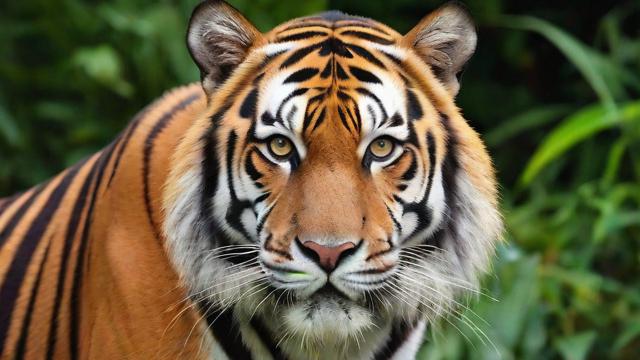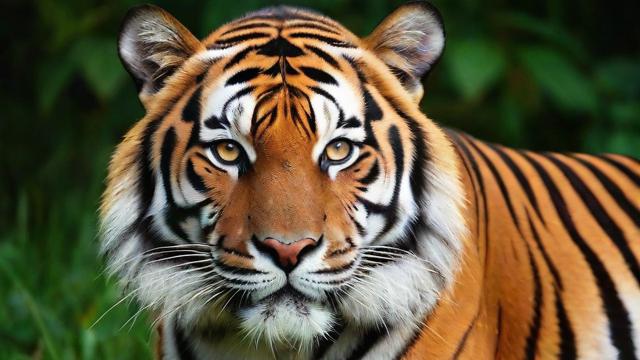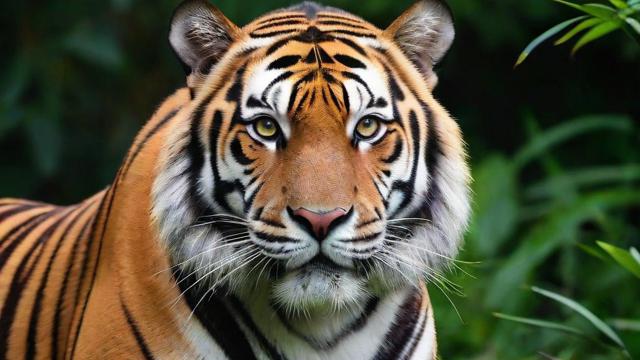探索虎类生态与文化价值:保护老虎的未来从了解开始 tiger
Tigers are more than just majestic animals. They play a vital role in maintaining the balance of ecosystems, and their presence has deep cultural significance across many societies. In this chapter, we will explore the various tiger species, their ecological importance, and how they have been woven into the fabric of human culture.
1.1 Overview of Tiger Species

When I think about tigers, the first thing that comes to mind is their striking orange coats with black stripes. But did you know there are actually several species of tigers? Each one has its own unique characteristics and adaptations. For example, the Bengal tiger is known for its vibrant coloring and lives primarily in India, while the Siberian tiger thrives in the cold forests of Russia. There’s also the Sumatran tiger, which is smaller in size but equally fascinating. These different species show how adaptable tigers can be depending on their environment.
In my travels, I’ve learned that each tiger species faces its own set of challenges. Some, like the South China tiger, are critically endangered due to habitat loss and poaching. It's heartbreaking to see such magnificent creatures struggling to survive. Understanding the diversity among tiger species helps us appreciate the complexity of their survival needs and highlights why conservation efforts must be tailored to fit specific populations.
1.2 Role of Tigers in Ecosystems
Tigers aren’t just beautiful animals—they’re also crucial players in the ecosystems where they live. As apex predators, they help control prey populations, ensuring that herbivores don’t overgraze and destroy plant life. This balance is essential for maintaining healthy forests and grasslands. Imagine what would happen if tigers disappeared from an area; the entire food chain could collapse, leading to imbalances that affect all living things.
From my perspective, seeing tigers in their natural habitats reinforces how interconnected everything is. A thriving tiger population often indicates a thriving ecosystem overall. When I visit places like national parks or reserves, it’s clear that protecting tigers means protecting countless other species too. Their presence serves as a sign of ecological health, making them a symbol of biodiversity preservation.
1.3 Cultural Significance of Tigers
Beyond their ecological role, tigers hold immense cultural value around the world. In many Asian cultures, they represent strength, courage, and power. You’ll find images of tigers in art, literature, and even traditional festivals. For instance, in Chinese culture, the tiger is one of the 12 zodiac signs, symbolizing bravery and leadership. Even in Western cultures, tigers are admired for their grace and ferocity, often appearing in stories and movies.
I remember visiting a temple once where a large statue of a tiger stood proudly at the entrance. The locals explained that it was meant to ward off evil spirits and bring good fortune. Stories like these remind me how deeply embedded tigers are in human history and beliefs. Protecting tigers isn’t just about saving a single species—it’s about preserving parts of our shared heritage as well.
Tigers are incredible creatures, but their survival depends heavily on the health of their habitats. In this chapter, we’ll dive into the different types of environments where tigers live, how they interact with their ecosystems, and the threats these habitats face today.
2.1 Types of Tiger Habitats
When people think about tiger habitats, they often picture dense jungles or lush forests. While that’s true for some species, tigers actually live in a variety of environments. For example, Bengal tigers thrive in tropical rainforests and grasslands in India, while Siberian tigers call the snowy taiga forests of Russia home. Sumatran tigers prefer the warm, humid swamps and mountains of Indonesia. Each habitat provides unique challenges and opportunities for these big cats.
From my own research, I’ve learned that tigers adapt remarkably well to their surroundings. In hot climates, they use water sources like rivers and lakes to cool down. In colder regions, their thick fur keeps them warm during harsh winters. It’s fascinating to see how versatile tigers can be when given the right conditions. However, not all habitats are created equal, and some are better suited for supporting large predator populations than others.
2.2 The Interdependence of Tigers and Their Ecosystems
Tigers don’t exist in isolation—they’re deeply connected to the ecosystems around them. As apex predators, they help maintain balance by regulating prey populations. This is important because overgrazing by herbivores can lead to soil erosion and loss of plant diversity. When tigers hunt deer or wild boar, they prevent these animals from overpopulating and damaging vegetation.

In my experience studying wildlife, I’ve seen firsthand how healthy tiger populations indicate thriving ecosystems. If there are enough tigers in an area, it usually means there’s plenty of prey, which in turn suggests abundant plants and resources. Protecting tigers isn’t just about saving one species—it’s about safeguarding entire ecosystems. Every part of the food chain relies on the other parts working together harmoniously.
2.3 Threats to Tiger Habitats
Unfortunately, many tiger habitats are under threat due to human activities. Deforestation for agriculture, logging, and urban expansion has destroyed vast areas of forest where tigers once roamed freely. Climate change is another major issue, altering weather patterns and making it harder for tigers to find food and water. Poaching remains a persistent problem as well, driven by demand for tiger parts in illegal markets.
As someone who cares deeply about conservation, I worry about the long-term effects of habitat destruction. Without safe spaces to live and hunt, tigers struggle to survive. Fragmented habitats also increase the likelihood of conflicts between humans and tigers, further endangering both sides. Addressing these threats requires global cooperation and innovative solutions, such as creating protected reserves and restoring damaged ecosystems.
In this chapter, we’ll explore the efforts being made to protect tigers and ensure their survival. From historical initiatives to modern strategies, there’s a lot happening in the world of tiger conservation. We’ll also look at some success stories and the challenges that still lie ahead.
3.1 History of Tiger Conservation
Tiger conservation hasn’t always been a priority, but over time, people have realized just how important these animals are. Back in the early 20th century, tigers were hunted almost without restriction. Their numbers plummeted as trophy hunters and poachers targeted them for sport or profit. It wasn’t until the 1970s that significant steps were taken to protect them. India launched Project Tiger in 1973, which set up reserves specifically designed to safeguard tiger populations. This was one of the first large-scale attempts to reverse the trend of declining tiger numbers.
From what I’ve read, the history of tiger conservation shows us just how far we’ve come. Governments began recognizing the need to act when they saw the devastating impact of unchecked hunting. International agreements like CITES (Convention on International Trade in Endangered Species) played a role too, helping reduce the illegal trade of tiger parts. These early efforts laid the groundwork for the more sophisticated approaches we see today.
3.2 Current Conservation Strategies
Nowadays, tiger conservation involves a mix of science, technology, and community involvement. One key strategy is setting up protected areas where tigers can live without fear of human interference. Rangers patrol these zones to prevent poaching and monitor tiger movements using camera traps and GPS collars. Another approach focuses on restoring degraded habitats so tigers have more space to roam.
I’ve learned that collaboration is essential for successful conservation. Scientists work alongside governments and local communities to develop plans tailored to each region. For example, in countries like Nepal and Bhutan, programs encourage villagers to participate in anti-poaching efforts. By involving everyone, conservationists increase the chances of long-term success. Technology plays a big role too—drones and satellite imagery help track changes in tiger habitats and detect illegal activities.
3.3 Success Stories and Challenges in Conservation
There are plenty of inspiring success stories in tiger conservation. Take Russia’s Amur tiger population, for instance. Thanks to strict laws and active conservation efforts, their numbers have increased significantly over the past few decades. Similarly, India has seen growth in its tiger population thanks to effective reserve management and community engagement. These achievements show that with dedication, it’s possible to bring tiger populations back from the brink.
Of course, challenges remain. Poaching continues to be a major threat, even in well-protected areas. Human-tiger conflicts often arise when tigers wander into villages searching for food. Climate change adds another layer of complexity, altering habitats and forcing tigers to adapt quickly. Despite these obstacles, conservationists remain hopeful. They know that every small victory brings us closer to ensuring tigers thrive in the wild.

In this chapter, we dive into what the future holds for tigers. We’ll explore emerging threats that could impact their survival, how technology is playing a bigger role in conservation efforts, and why involving communities and fostering global cooperation is crucial. It’s an exciting yet challenging time for tiger conservation, and understanding these aspects can help us better support their long-term survival.
4.1 Emerging Threats to Tigers
The journey to protect tigers isn’t over, and new challenges keep popping up. One of the biggest emerging threats is climate change. As temperatures rise and weather patterns shift, tiger habitats are changing too. Forests might become less suitable for them, forcing tigers to move elsewhere. This movement puts them at risk of encountering humans more frequently, leading to conflicts like attacks on livestock or even people. I’ve read about cases where villagers retaliate against tigers after such incidents, which only makes things worse for both sides.
Another issue gaining attention is infrastructure development. Roads, railways, and dams are being built deeper into forests, cutting through tiger territories. These projects fragment habitats, making it harder for tigers to find mates or hunt effectively. Imagine if you were trying to cross a busy highway just to get to your grocery store—it’d be dangerous, right? That’s exactly what tigers face when their paths are blocked by roads or railways. Addressing these threats requires creative solutions and forward-thinking planning.
4.2 Technological Innovations in Tiger Conservation
On the brighter side, technology is stepping up big time to help save tigers. For example, camera traps are now smarter than ever. They use AI to recognize individual tigers based on their stripe patterns, giving researchers valuable data without disturbing the animals. Drones equipped with thermal sensors can patrol large areas quickly, spotting poachers before they strike. I think it’s amazing how tech like this levels the playing field for conservationists who often work with limited resources.
There’s also genetic analysis coming into play. By studying tiger DNA, scientists can learn about population health, migration patterns, and even identify illegal trade routes. Satellite imagery helps monitor habitat changes over time, showing where restoration efforts should focus. All these advancements give us powerful tools to tackle problems head-on. It feels like we’re entering a golden age for wildlife conservation thanks to all these innovations.
4.3 Community Involvement and Global Cooperation
When it comes to saving tigers, no one group can do it alone. Communities living near tiger habitats play a vital role. Programs that involve locals in monitoring wildlife or offering alternative livelihoods reduce the pressure on tigers. For instance, some villages in India have turned to eco-tourism, where visitors pay to see tigers in the wild. This creates jobs and gives people a reason to protect the animals instead of seeing them as pests.
Global cooperation is equally important. Tigers roam across borders, so countries need to work together to share knowledge and coordinate efforts. International funding supports projects in regions where resources are scarce. When I think about it, it’s not just about protecting tigers—it’s about building a world where humans and wildlife can coexist peacefully. With everyone pitching in, there’s real hope for the future of these majestic creatures.














